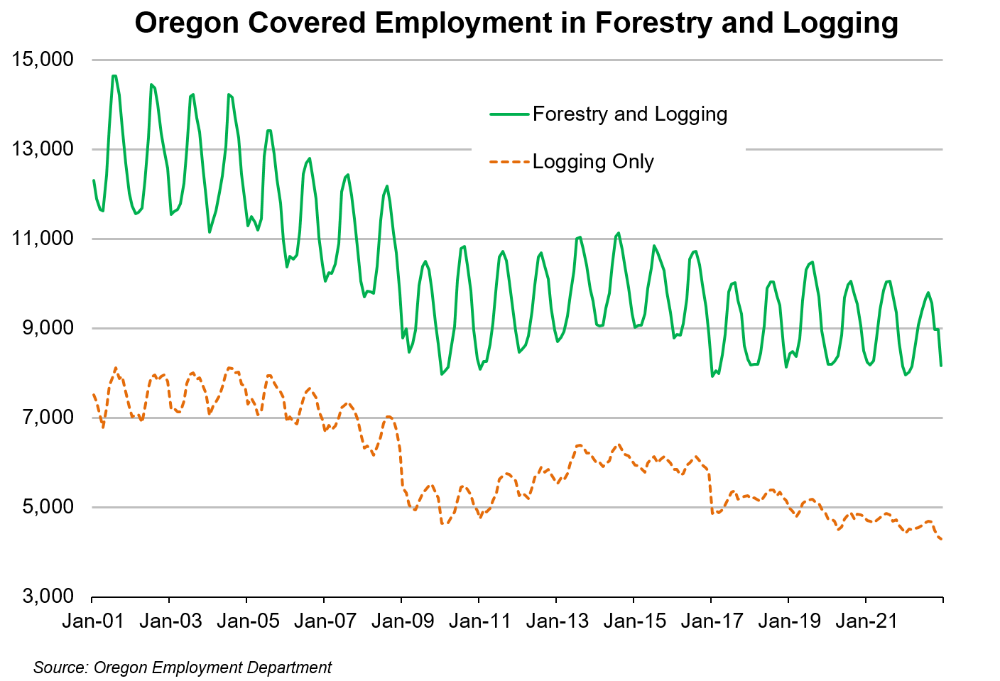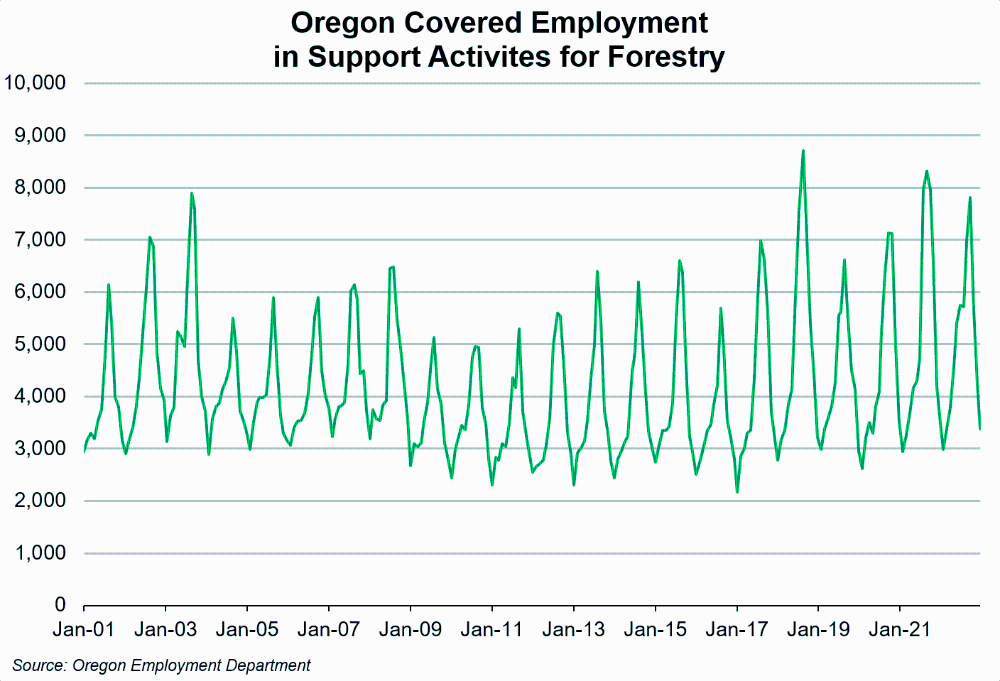Oregon’s Forestry and Logging Industry: From Planting to Harvest

Oregon is one of the world’s great tree-growing areas. The state’s soils and climate provide ideal conditions to grow such commercially viable species as Douglas fir and ponderosa pine. Forests cover more than 30 million of Oregon’s 62 million acres – almost half of the state’s landmass.
The Oregon Department of Forestry (ODF) estimates logging harvests totaled 3.9 billion board feet in 2021. While much of this timber feeds Oregon’s wood products industry, creating jobs and income, many jobs are also created planting, growing, and harvesting this resource.
Forestry and Logging Industry Employment
Firms in forestry and logging grow and harvest timber on a long production cycle, generally of 10 years or more. Timber production requires natural forests or suitably large areas of land that are available long term. Oregon’s often mountainous and remote terrain, in both public and private ownership, provides that land base.
The forestry and logging subsector is made up of three industries:
- Timber tract operations
- Forest nurseries and gathering of forest products
- Logging
According to the Oregon Employment Department’s covered employment statistics, forestry and logging’s 710 establishments employed 8,869 workers statewide and added $650 million in payroll to Oregon’s economy in 2022.
Employment was in decline between 2005 and 2009 and has since leveled off. It is currently varying seasonally in a band between 8,000 and 10,000 jobs.
Of the 2022 annual average total, 5,056 were employed in the private sector while 3,812 were employed in government. Most of the government employment is in federal government at 3,636 while the rest is in state government.
Covered employment is a count of workers covered by Oregon’s unemployment insurance (UI) program. Self-employed individuals are generally not included in the program and, therefore, not counted. However, the U.S. Census Bureau produces nonemployer statistics. A nonemployer business is one that has no paid employees, has annual business receipts of $1,000 or more, and is subject to federal income taxes. In addition to covered employment, forestry and logging had 1,485 nonemployers in Oregon in 2019. Gross income for these companies was $99 million. Although there is no further industry breakout, it is likely that many of these self-employed are involved in timber tract operations and the gathering of forest products.
Forestry and logging is a highly seasonal industry. Employment generally grows throughout the spring and peaks in August. Employment often stabilizes for a month or two in the fall before dropping off as winter rains begin.
The largest industry in the forestry and logging subsector is logging, which totaled 588 reporting units and 4,520 employees in 2022. The logging industry, with a statewide annual average wage of $59,714 in 2022, pays a little less than the statewide average wage of $66,342 for all industries. Major occupations in this industry include loggers, equipment operators, truck drivers, and fallers and buckers. Logging shows a similar seasonality to the overall sector, except with less volatility.
The second-largest industry of employment in forestry and logging is timber tract operations, employing 4,161 on an annual average basis in 2022. Timber tract operations employment is largely government employment. In 2022, 3,636 federal workers and 166 state workers managed government forestlands. The remaining 359 were in the private sector. In addition to forest workers, many occupations in this industry are managerial or professional and require a high level of experience and education. Wages, therefore, are relatively high – $89,221 in 2022.
The industry with the least employment in the forestry and logging subsector is forest nurseries and gathering forest products, with only 13 establishments and covered employment of 188 in 2022. Much of the work in this industry is sporadic or seasonal, which contributes to the relatively low annual average wage of $47,291. The covered employment numbers for this industry may be low since many of the entities that gather forest products are sole proprietors or family operations that are not covered by UI law.
Long-term Decline but Stabilization after the Great Recession
From 1990 to 2000, forestry and logging employment declined from 15,774 jobs statewide to 12,887, a loss of 2,887 jobs or 18%. During that period, timber harvests in Oregon declined from 6.2 billion board feet to 3.9 billion board feet. The decline was due largely to environmental concerns and the resulting decrease of harvests from public lands. In 1990, the Oregon Department of Forestry reported 48% of timber cut for the lumber and wood products industry came from public lands. Over time, restrictions took a toll, and the harvest from public lands in Oregon dwindled to 18% of the total in 2007.
Due to low interest rates along with a record level of housing starts and an increase in lumber prices in the western U.S., the 2004 timber harvest level of 4.5 billion board feet was the highest since 1993. A few years later, western housing starts declined due to a nationwide recession. Timber harvest levels also declined to 3.8 billion board feet in 2007. Correspondingly, employment in forestry and logging dropped 1,898 jobs, or 15% from 2004 to 2008.
With the end of the Great Recession in 2009, the industry stabilized. Since then, forestry and logging employment has been relatively stable compared with previous periods, going from annual average employment of 9,329 in 2009 to 8,867 in 2022.
Some of the long-term decline in employment in forestry and logging was due to increased mechanization. A simple way to look at the efficiency created by mechanization is to look at the volume of timber harvested per logging worker. Harvests averaged 550,400 board feet per logging worker in 1990. By 2021, that figure had risen to 822,841 board feet per worker.
The forestry and logging industry was one of the industries least affected by restrictions put in place due to the COVID-19 pandemic, gaining about 2% of its employment between February and April 2020 due to a seasonal increase compared with 13% decline for all industries. On an annual average basis, forestry and logging employment dropped 3% in 2020 compared with 6% for all industries.
Support Activities for Forestry
The high level of forestry activity in Oregon also creates demand for a support activities industry. In 2022, support activities had covered employment of 4,971 and provided $278 million in payroll. In addition, there were 456 nonemployer businesses with gross income of $26 million in 2019. Included in this industry are firms that replant forests, fight forest fires, thin forests, and provide information to the timber industry.
Employment in support activities has been stable through time generally staying between 3,500 and 4,500 over the past 20 years on an annual average basis. Employment increased recently though, at 5,134 in 2021 due to firefighting and replanting after busy fire seasons.
At $55,956 in 2022, annual average covered wages in this industry were below the all-industry average of $66,342. Seasonal, sporadic, and part-time work are prevalent and often bring down the annual average but like employment, wages rose in 2021, reaching $61,057, likely due to busy fire seasons.
The support activities for forestry industry was one of the least affected by restrictions enacted due to COVID-19. The industry gained 82 jobs between February and April 2020 compared with 13% loss for all industries. On an annual average basis, the industry gained 4% in 2020 compared with a loss of 6% for all industries.
Like forestry and logging, the support activities industry is highly seasonal. The year usually starts with tree planting in the late winter and into spring, depending on the slope and elevation. Firefighting then picks up in the summer, usually peaking around August.
The support activities industry has become very mobile and flexible, with Oregon companies planting trees, thinning brush, and fighting forest fires throughout the Pacific Northwest and beyond. Some Oregon companies in this industry take part in more than one of these activities, often far from Oregon. As Cassandra Moseley of the University of Oregon’s Ecosystem Workforce Program points out, “A company can do all three in an area once they have the transportation and people that are willing to work hard.”
Another major portion of the support activities industry is replanting forests after logging. In 1971, Oregon enacted the Oregon Forest Practices Act, making it the first state in the nation to set rules to ensure a continuous harvest of timber. As a result, according to the Oregon Forest Resources Institute, about 40 million seedlings are planted in Oregon each year.
Outlook
Employment Department projections show that the logging industry in Oregon is expected to lose about 200 jobs, or 4% between 2021 and 2031. Logging was one of the industries least affected by restrictions enacted due to the COVID-19 pandemic so it will not have as strong a rebound as the overall economy going forward. Other industries within timber production, such as timber tract operations and support activities for forestry do not have published Oregon Employment Department forecasts.
by Brian Rooney – Regional Economist – Douglas and Lane counties – Oregon Employment Department
https://www.qualityinfo.org/-/oregon-s-forestry-and-logging-industry-from-planting-to-harvest-1
Photo by everett mcintire on Unsplash


Advertisement